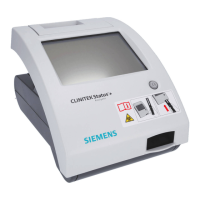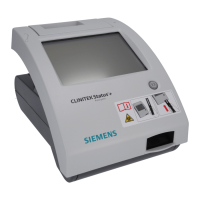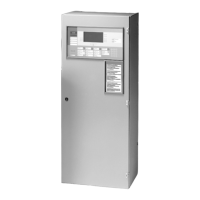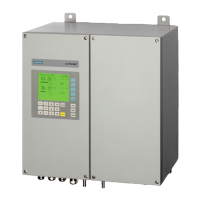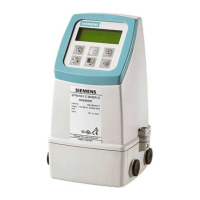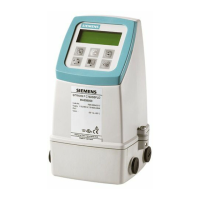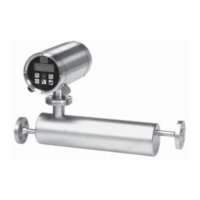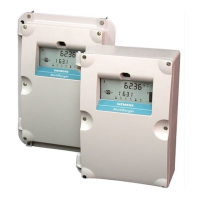Do you have a question about the Siemens Clinitek Advantus and is the answer not in the manual?
Describes the physical components and their arrangement on the analyzer.
Details interaction via touch screen, keyboard, or barcode reader.
Explains the fixed platform's sections for strip loading, incubation, and waste.
Outlines power connection and interface ports for peripherals.
Covers storage for software, parameters, and results in flash and RAM.
Introduces the analyzer's user interface and navigation.
Details the step-by-step process of analyzing a reagent strip.
Procedures to follow before starting a sample run.
Instructions for running quality control samples.
Steps for testing standard urine samples.
How to test samples without pre-defined IDs or loadlists.
Procedures for entering and managing specimen ID lists.
How to enter loadlist data using the analyzer interface or keyboard.
How to transfer loadlists from external systems.
How to run urgent STAT tests within a loadlist.
Steps to stop or cancel an ongoing test run.
Covers end-of-run reports and editing flagged results.
Instructions for retrieving stored patient and QC results from memory.
Procedures for printing and sending results from memory.
Explains how the analyzer performs calibration before each strip read.
Procedure to print a report of the last successful calibration.
Step-by-step guide for running QC tests with control solutions.
Lists common QC causes and their corrective actions.
Instructions for cleaning the analyzer exterior.
Detailed steps for cleaning key analyzer components.
Procedure for disinfecting analyzer parts using specific solutions.
Explains error messages and how to resolve issues.
Steps to clear a test strip jammed in the readhead.
Procedure for correctly reinstalling the fixed platform.
A table listing symptoms, causes, and remedies for common errors.
Provides detailed steps for setting up the analyzer.
Steps for setting up the analyzer, including recording warranty info.
How to connect power, printers, computers, and barcode readers.
A mandatory procedure to verify analyzer installation and function.
General guidance on using setup options to customize the analyzer.
Specifying interface parameters for host computer communication.
Configuring network settings for sending results to a local network.
Setting parameters for handheld barcode reader labels.
Running diagnostic tests on analyzer hardware components.
Final steps to save settings and print a setup report.
Guidelines for safe handling of biohazardous materials in the lab.
Common issues and solutions related to barcode reading errors.
Describes the physical components and their arrangement on the analyzer.
Details interaction via touch screen, keyboard, or barcode reader.
Explains the fixed platform's sections for strip loading, incubation, and waste.
Outlines power connection and interface ports for peripherals.
Covers storage for software, parameters, and results in flash and RAM.
Introduces the analyzer's user interface and navigation.
Details the step-by-step process of analyzing a reagent strip.
Procedures to follow before starting a sample run.
Instructions for running quality control samples.
Steps for testing standard urine samples.
How to test samples without pre-defined IDs or loadlists.
Procedures for entering and managing specimen ID lists.
How to enter loadlist data using the analyzer interface or keyboard.
How to transfer loadlists from external systems.
How to run urgent STAT tests within a loadlist.
Steps to stop or cancel an ongoing test run.
Covers end-of-run reports and editing flagged results.
Instructions for retrieving stored patient and QC results from memory.
Procedures for printing and sending results from memory.
Explains how the analyzer performs calibration before each strip read.
Procedure to print a report of the last successful calibration.
Step-by-step guide for running QC tests with control solutions.
Lists common QC causes and their corrective actions.
Instructions for cleaning the analyzer exterior.
Detailed steps for cleaning key analyzer components.
Procedure for disinfecting analyzer parts using specific solutions.
Explains error messages and how to resolve issues.
Steps to clear a test strip jammed in the readhead.
Procedure for correctly reinstalling the fixed platform.
A table listing symptoms, causes, and remedies for common errors.
Provides detailed steps for setting up the analyzer.
Steps for setting up the analyzer, including recording warranty info.
How to connect power, printers, computers, and barcode readers.
A mandatory procedure to verify analyzer installation and function.
General guidance on using setup options to customize the analyzer.
Specifying interface parameters for host computer communication.
Configuring network settings for sending results to a local network.
Setting parameters for handheld barcode reader labels.
Running diagnostic tests on analyzer hardware components.
Final steps to save settings and print a setup report.
Guidelines for safe handling of biohazardous materials in the lab.
Common issues and solutions related to barcode reading errors.
| Test Types | Urinalysis |
|---|---|
| Interface | RS-232, USB |
| Calibration | Automatic calibration |
| Measurement Principle | Reflectance photometry |
| Sample Type | Urine |
| Power Supply | 100-240 VAC, 50/60 Hz |
| Type | Urine analyzer |
| Display | Touchscreen |
| Reagent Type | Test strips |
| Measurement Parameters | Glucose, Bilirubin, Ketone, Specific Gravity, Blood, pH, Protein, Urobilinogen, Nitrite, Leukocytes |
